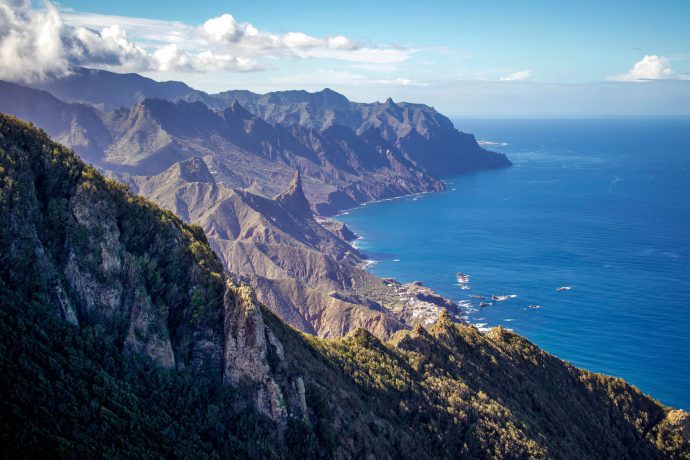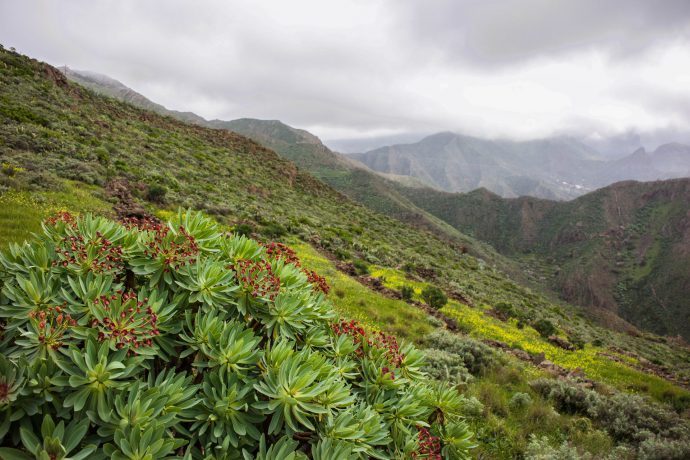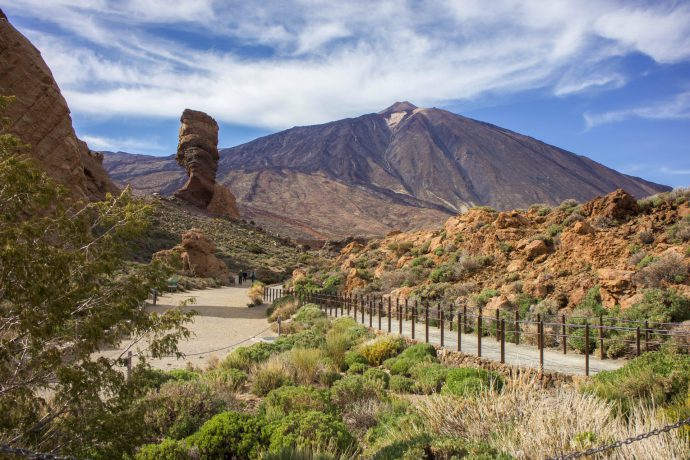Spring is for many visitors the best season of the year. The days start to get longer and Tenerife’s landscapes are bursting with colour everywhere. The camera fills with images where the green is enriched with a wide range of yellows, reds, blues and violets, provided by the striking flowers that proliferate in every corner of the island. Although the island boasts an “eternal spring” that allows plants to be in bloom all year round, it is undoubtedly with the arrival of March that there is an obvious explosion of vitality.
Nature’s palette of colours is very noticeable both in the most unspoilt and best-preserved areas of Tenerife, such as the Parque Rural de Anaga, the Parque Rural de Teno, or the Parque Nacional del Teide, and in the many discreet gardens that are so common in the more urbanised areas of the island. The plants begin to put on their finery at the end of February and during the month of March they blossom in the great celebration of spring. Visiting Tenerife in spring is a safe and unforgettable bet.

Unforgettable landscapes during spring
Tenerife has a subtropical climate with little variation. The island’s mild temperatures average between 18 and 24 degrees Celsius, which makes it a year-round paradise.
The month of March is specially marked in the calendar and after the spring equinox, Tenerife’s landscapes take on a much more beautiful and extraordinary dimension. The start of spring is a spectacle for the eyes that activates all the senses. In short, it is an ideal occasion to visit and discover the unique nature of the largest of the Canary Islands.
Excursions in the natural environment during this season are unrepeatable experiences to enjoy this burst of life and colour. During them, a highly recommendable activity is to capture in an image and try to recognise some of the most striking plants that we will come across along the way. A task that can be simplified, despite the fact that nature in Tenerife is extremely diverse.
Tenerife’s flora is characterised by its great variety, dominated by native species, many of which are endemic, growing wild, to which must be added numerous introduced exotic species. All of them surprise visitors. Recognising and remembering the names of all the plants on the island is a task only for specialists. However, the most abundant and striking ones will soon be familiar to us, and photographing some of the plants that characterise the island’s landscapes is a beautiful souvenir. Among the plants of Tenerife you are sure to find your favourite.
Recommended places to visit during the spring in Tenerife
Teno Rural Park

A day trip to Teno is possible by taking a short drive, stopping at the different viewpoints, visiting some of the villages and, of course, tasting some of the local products, such as cheese.
The Teno massif is impressive all year round, but even more so in spring. This protected area is located in the northwest corner of Tenerife. In its interior we find small hamlets such as El Palmar, Los Bailaderos, Teno Alto, Los Carrizales, Las Portelas, Las Lagunetas and Masca, dotted throughout its rugged landscape. Each one of them preserves a different and unique beauty.
However, getting to know Teno requires you to put on some good boots, take your backpack, food, water, warm clothes and start walking. The variety of landscapes and stories of the Teno massif are endless. Each hike surprises as much or more than the previous one.
During the spring, the landscapes of Teno are full of life and colour. From the plants that grow near the coast, where the cardón (Euphorbia canariensis) and the sweet tabaiba (Euphorbia balsamifera) are the most striking, to the highest areas where the monteverde (laurisilva) is established, where the exuberant trees of this formation proliferate. Between the two extremes there is a proliferation of white tajinastes (Echium aculeatum), white broom (Retama monosperma), tabaibas majoreras (Euphorbia atroporpurea), lavender (Lavandula canariensis) and cerrajones (Sonchus acaulis). Some palm trees (Phoenix canariensis) and dragon trees (Dracaena draco) also stand out in the landscape. Many botanical treasures are exclusive rock species secluded on the ledges of the steep ravines and cliffs. A set of landscapes in which herds of goats support one of Teno’s richest delicacies, cheese.
Anaga Rural Park
Misty and humid, this is the Anaga Rural Park. One of the oldest and greenest areas of the island, located in the extreme east of Tenerife, very close to the capital Santa Cruz de Tenerife.
The Anaga massif is wild. It represents a magnificent sample of the traditional and rural culture of Tenerife. Different hamlets dot its mountains and fill the steep ravines that cross it with life.
Places such as Chamorga, Batanes, Afur, Las Carboneras or Chinamada are full of life and colour with the arrival of spring. As in the Teno massif, the recommendation in Anaga is to leave the main road and choose one of the numerous trails that run through its interior. Anaga is an island within an island.
From the coast to the summit, Anaga is all colourful. The palette becomes infinite. In Anaga, the laurel forest is particularly well represented, a forest in which the noblest trees coexist: acebiños, heathers, fayas, daisies, laurels, wild orange trees, tiles, vinatigos, etc.., and which allow numerous ferns to flourish in their shade or in their clearings, such as the black pokeweed (Woodwardia radicans), and countless spectacular species that dazzle in flower, such as the bicácaro (Canarina canariensis), the morgallana (Ranunculus cortusifolius), the cockscomb (Isoplexis canariensis), or the mountain geranium (Geranium canariense). On the slopes of the large ravines that make up the Anaga massif there is an abundance of bejeque (Aeonium canariense), white tajinaste (Echium virescens), lavender (Lavandula canariensis) and gamona (Asphodelus tenuifolius), which are responsible for the explosion of life and colour in spring.
Teide National Park

The Teide National Park, located in the heart of Tenerife, offers one of the most breathtaking landscapes on the island during any season of the year. A visit to its different viewpoints is an unforgettable journey to another planet.
Among volcanoes, domes, aa and pahoe-hoe lava flows, craters of different sizes and volcanic materials of hundreds of colours, grows a unique vegetation adapted to the singularities of the high mountain climate. The variety of colours becomes blinding during certain months of the year.
In the months of April and May the landscape of the Teide National Park reaches a level of beauty that is difficult to match, as one of the great natural spectacles of Tenerife takes place with the flowering of the red tajinaste (Echium wildpretii), creating a totally magical atmosphere.
This endemic plant is long overdue. When a large part of the park’s vegetation has already flowered, its moment of glory begins. As if it were a wedding, when the guests have taken their places, the great protagonist of the day arrives. In this case, of the season. With her presence, silence falls.
The elegant red tajinaste is surrounded by a majestic cast of exclusive species that compete in beauty: the spicy tajinaste (Echium auberianum), the cod (Adenocarpus viscosus), the broom (Spartocytisus supranubius) with its unmistakable scent that perfumes the whole park, together with the more modest Teide wallflower (Erysimum scoparium), Teide daisy (Argyrathemum teneriffae), summit rosebush (Pterocephalus lasiospermus), tonática (Nepeta teydea) and hierba pajonera (Descurainia bourgaeana). Not forgetting the small plant that has the honour of growing at the highest altitude on the island, the Teide violet (Viola cheiranthifolia).
Tenerife is an immense garden
In addition to the unique landscapes mentioned above, the island has countless landscaped areas and valuable botanical gardens such as those in Puerto de la Cruz, La Orotava and Santa Cruz de Tenerife. In both of these gardens, it is possible to enjoy a magnificent representation of exotic species, which add to the springtime offer of the island of Tenerife.
Any time of year is a great time to visit Tenerife, but Tenerife’s eternal spring is particularly great during the months of March, April and May, when the whole island is a garden in bloom.
